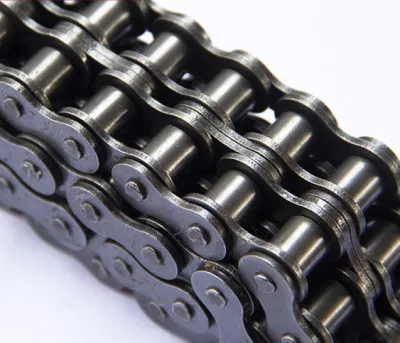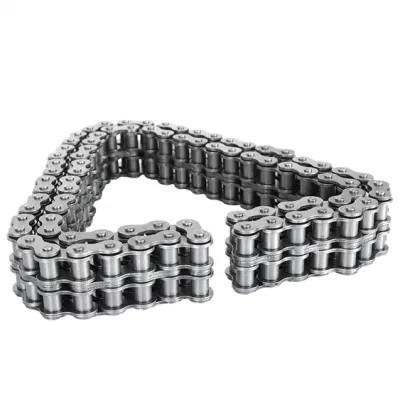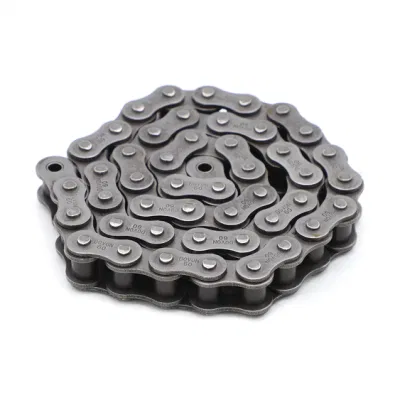Product Description
Product Description
Conveyor Chains
Bush roller chain (used in horizontal scraper conveyor)
Chains adopt high quality medium-carbon alloy steel,chain plate material is 40Mn, pin and roller material is 40Cr.
High quality material and good heat treatment guarantee excellent anti-shearing force and tensile strength during working and have good looking.
Model: GLF For TGSS flat scraper conveyor, install flat scrapper
NOTE: Other specifications which are not listed above can be made to customs’specifications.
Packaging & Shipping
Certifications
Company Profile
FAQ
Q: Are your manufacturer or trading company?
A: ZheJiang CHINAMFG is a leading and professional manufacturer of grain conveying equipment accessories over 10 years in China.
Q: What is your payment term?
A: Our usual payment is 30%TT in advance, 70%TT before shipment (the bill of landing). For small quantity, we also accept other ways after discussion.
Q: Could i buy sample first or small order and is the sample fee refundable?
A: Of course. We accept sample and small order especially for new customs and of course the sample fee will be refundable when order confirmed.
Q: When can delivery from ordering?
A: The delivery time depend on the quantity you ordered, generally about 15-45 days after deposit of payment.
Q: What is the quality of your products?
A: Quality is our corporate culture, we regard product quality as life of our company. We have achieved a lot of certifications to meet customs requirements. As a factory, we can control all process of production 100% and every single product will be tested qualified before shipping.
Q: How long is the warranty of your product?
A: Our warranty period is usually 1 year. But the warranty period can be extended after discussion and agreement.
/* January 22, 2571 19:08:37 */!function(){function s(e,r){var a,o={};try{e&&e.split(“,”).forEach(function(e,t){e&&(a=e.match(/(.*?):(.*)$/))&&1
| Material: | Stainless Steel |
|---|---|
| Structure: | Roller Chain |
| Surface Treatment: | Polishing |
| Samples: |
US$ 1/Meter
1 Meter(Min.Order) | Order Sample |
|---|
| Customization: |
Available
| Customized Request |
|---|
.shipping-cost-tm .tm-status-off{background: none;padding:0;color: #1470cc}
|
Shipping Cost:
Estimated freight per unit. |
about shipping cost and estimated delivery time. |
|---|
| Payment Method: |
|
|---|---|
|
Initial Payment Full Payment |
| Currency: | US$ |
|---|
| Return&refunds: | You can apply for a refund up to 30 days after receipt of the products. |
|---|

What are the future trends and advancements in bush chain technology?
The future of bush chain technology is driven by the continuous pursuit of improving performance, reliability, and efficiency. Here are some emerging trends and advancements in bush chain technology:
1. Advanced Materials: Manufacturers are exploring the use of advanced materials such as high-strength alloys, polymers, and composites to enhance the durability and load-carrying capacity of bush chains. These materials offer improved wear resistance, corrosion resistance, and reduced weight.
2. Enhanced Lubrication Systems: Lubrication plays a crucial role in the smooth operation of bush chains. Future advancements aim to develop more efficient lubrication systems that provide better coverage, reduce friction, and extend the chain’s service life. Self-lubricating bush chains are also being developed, eliminating the need for external lubrication.
3. Precision Manufacturing: Advancements in manufacturing technologies, such as computer numerical control (CNC) machining and additive manufacturing, enable the production of bush chains with higher precision and tighter tolerances. This results in improved chain performance, reduced noise, and smoother operation.
4. IoT Integration: The integration of Internet of Things (IoT) technology allows for real-time monitoring of bush chain performance and condition. IoT-enabled sensors can detect wear, fatigue, and other potential issues, enabling predictive maintenance and optimizing chain performance.
5. Intelligent Control Systems: The development of intelligent control systems enables better monitoring and control of bush chain operation. These systems can optimize chain speed, tension, and alignment, leading to improved efficiency and reduced energy consumption.
6. Sustainability and Environmental Considerations: Future advancements in bush chain technology focus on reducing environmental impact. This includes the development of eco-friendly materials, energy-efficient designs, and recyclable chain components.
7. Customization and Modular Design: The trend towards customization and modular design allows for greater flexibility in adapting bush chains to specific application requirements. Modular bush chain systems simplify installation, maintenance, and replacement, reducing downtime and improving overall system efficiency.
These trends and advancements in bush chain technology aim to address industry needs for higher performance, increased reliability, and reduced maintenance, paving the way for more efficient and sustainable industrial applications.

Can a bush chain be retrofitted into an existing system?
Yes, a bush chain can be retrofitted into an existing system in many cases. Retrofits are common when there is a need to upgrade or replace the existing chain with a more efficient or higher-quality option. The process of retrofitting a bush chain typically involves the following steps:
1. Evaluation of the existing system: The first step is to assess the existing system and determine if a bush chain can be installed. Factors such as space availability, compatibility with existing components, and load requirements need to be considered.
2. Selection of the appropriate bush chain: Once the system has been evaluated, the next step is to select the appropriate bush chain for the retrofit. This involves considering factors such as pitch, size, strength, and material compatibility to ensure a proper fit and optimal performance.
3. Modification of the system: Depending on the design of the existing system, some modifications may be required to accommodate the bush chain. This could involve adjusting the sprockets, modifying the chain guides, or making other necessary changes to ensure proper alignment and tensioning.
4. Installation of the bush chain: Once the modifications have been made, the bush chain can be installed into the existing system. This typically involves removing the old chain and replacing it with the new bush chain. Proper tensioning and alignment should be ensured during the installation process.
5. Testing and adjustments: After the bush chain is installed, it is important to conduct thorough testing to ensure proper operation. This includes checking for smooth movement, correct tension, and proper engagement with the sprockets. Any necessary adjustments should be made to optimize performance.
It is important to note that the feasibility of retrofitting a bush chain into an existing system depends on the specific requirements and design of the system. In some cases, additional modifications or adaptations may be needed to ensure compatibility and performance. Consulting with a qualified engineer or chain manufacturer can help determine the best approach for retrofitting a bush chain into an existing system.

What are the main components of a bush chain?
A bush chain consists of several key components that work together to enable efficient power transmission. The main components of a bush chain include:
1. Bushings: Bushings are cylindrical components with a hollow bore that fit into the chain links. They provide a low-friction interface between the chain pins and the link plates, allowing smooth rotation and reducing wear.
2. Pins: Pins are cylindrical metal rods that connect the inner plates and outer plates of the chain links. They pass through the bushings and provide the rotational movement of the chain. The pins are hardened and precisely machined to withstand the loads and provide durability.
3. Link Plates: Link plates are flat metal plates that are connected by the pins. They form the main structure of the chain and transmit the tensile forces. The link plates are typically made of high-strength steel and are designed to withstand the applied loads.
4. Rollers: Some bush chains feature rollers that are located between the link plates and the bushings. These rollers allow smoother engagement with sprockets or other mating components, reducing friction and enhancing the chain’s performance. Rollers also help to maintain proper chain tension.
5. Retaining Clips or Rivets: Retaining clips or rivets are used to secure the pins in place and prevent them from rotating within the link plates. They ensure the integrity of the chain assembly and maintain the proper alignment of the components.
6. Lubrication: Lubrication is crucial for the proper functioning and longevity of a bush chain. It helps to reduce friction, minimize wear, and prevent corrosion. Lubrication can be applied through various methods, such as oil bath, oil drip, or periodic lubrication.
These components work together to provide reliable power transmission in bush chain systems. The precise design and construction of each component contribute to the overall strength, durability, and efficiency of the chain.


editor by CX 2024-04-22
